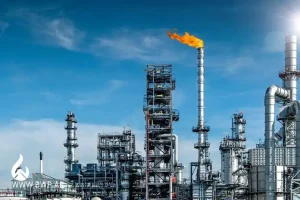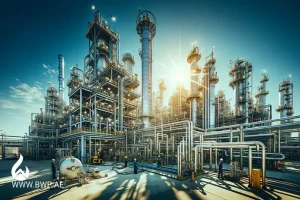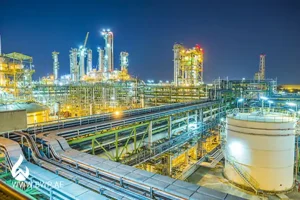The increase in population also increases the need. Natural fibers, cloth bags or wooden wheels can no longer be used. For these problems, substances derived from petrochemicals came to the aid of man. In general, these products have a history of hundreds of years. Due to the great need for petrochemicals, it is very important to know their structure, how to extract and purify them, and how to store and ship them. In the remainder of this text, we intend to discuss in detail the structure of petrochemicals, how they are extracted, and related materials.
Base Oil Group 3 Products BWP : Base oil 8cst , Base oil 6cst
Defining Petrochemicals and Why They Are Important
Petrochemicals are petroleum- and natural gas-based chemical products. They are not fuels that get consumed by being burned, like gasoline or diesel, to be used as raw materials—”building blocks,” as it were—to manufacture an enormous variety of industrial and consumer goods. They are the products that include plastics, synthetic rubber, solvents, fertilizers, drugs, detergents, and even textiles.
What is so vital about petrochemicals is their pervasiveness in modern life. From the packaging material for your food to the medical devices used in hospitals and the insulation in buildings, petrochemical-based products are everywhere. Their importance extends beyond consumer products—without them, whole industries like automotive, agriculture, construction, and electronics would not exist.
Strategically and economically, petrochemicals are high-value-added products that optimize the profitability of the oil and gas value chain. To such firms as Black Water Petrochemical, they represent a critical confluence of refining efficiency, market demand, and international trade. Availability of secure and affordable petrochemical supply chains is an anchor of industrialization in the world today.

For more information, read the article linked below:
Base Oil Supply Chain Challenges and Solutions in 2025
Origin of Petrochemical Raw Materials
The journey of petrochemicals begins millions of years under the Earth, where crude oil and natural gas are formed. The fossil fuels are the primary feedstocks employed for petrochemical production. When extracted, they are processed through refining processes that divide them into individual fractions such as naphtha, ethane, propane, and butane—each a feedstock for petrochemical manufacture.
Naphtha, a light hydrocarbon mixture obtained from the distillation of crude oil, is a most typical feedstock for the production of olefins and aromatics. Natural gas liquids like ethane and propane are typically generated in natural gas processing and have become important in regions with abundant shale gas reserves.
Sourcing and storing these feedstocks are central activities in Black Water Petrochemical. The purity and stability of these feedstocks have direct implications for the efficiency of downstream synthesis and cracking operations. An understanding of their provenance is vital to the optimization of costs, yields, and sustainability in petrochemical production.
Classification of Petrochemicals by Composition
Petrochemicals can be broadly classified based on chemical composition and molecular structure. They belong to the three broad categories of olefins, aromatics, and syngas derivatives, each having varying properties and applications in industries.
Olefins are unsaturated hydrocarbons with one or more double bonds, and they are highly reactive and versatile. Ethylene, propylene, and butadiene are significant olefins produced largely through steam cracking. They are the basic building blocks for plastics like polyethylene, polypropylene, and synthetic rubbers.
Aromatics, on the other hand, are hydrocarbons that contain stable ring-shaped molecular structures. The most common aromatics—benzene, toluene, and xylene (BTX)—are obtained by catalytic reforming or as cracking by-products. The chemicals are the main building blocks of dyes, detergents, adhesives, resins, and synthetic fibers.
Syngas derivatives—methanol and ammonia—are manufactured from a blend of hydrogen and carbon monoxide. These chemicals play important roles in the manufacture of fertilizers, solvents, and acetic acid.
This classification is not just abstract—it helps traders, refiners, and petrochemical manufacturers like Black Water Petrochemical decide best production strategies, match feedstocks with product markets, and manage downstream integration. Each category has its own refining pathways, market dynamics, and end-user industries, and chemical composition is thus a key frame of reference for strategic decision-making.

For more information, read the article linked below:
Top Safety Standards for Oil Storage Facilities Around the World
Olefins vs. Aromatics: Key Categories Explained
Olefins and aromatics-would be the two most commercially significant classes of petrochemicals as measured by production volume and end-use in industry. The chemistry and roles of these compounds should be understood in developing refining strategies and downstream planning.
Olefins are unsaturated hydrocarbons with carbon-carbon double bonds; they include ethylene, propylene, and butadiene. These molecules are very reactive and are the building blocks for numerous polymer-based materials. For example, ethylene is used to produce polyethylene (in packaging), ethylene glycol (as antifreeze and polyester), and PVC. Propylene is vital for polypropylene and acrylonitrile, which are subsequently used in the automotive sector as well as in textiles.
Aromatics form the ring-structured hydrocarbons like benzene, sometimes toluene, and xylenes (often combined as BTX). Benzene is for styrene manufacturing (for polystyrene), ny- lon precursors, and other resins. Toluene and xylenes are essentially solvents, synthetic fibers, and performance plastics.
Olefins are usually produced by the steam cracking of ethane, propane, or naphtha. Aromatics are produced primarily in catalytic reforming of naphtha or as by-products in cracking units.
This would thus be basically for Black Water Petrochemical in an event when it should master these three critical aspects of supply, trade, and storage in relation to these two petrochemicals: olefins and aromatics, as this is fairly important in times of responding to global demand shifts and integration of the whole petrochemical value chain.
Refining-cracking roles in petrochemical production
transformation of crude oil and natural gas into valuable petrochemical resources are complex refining and cracking processes. Such methods are of great significance not only in separating and purifying hydrocarbons but in converting them to much more “reactive”, or “desired” forms out of which they continue chemical processing.
The crude oil fractionates in a typical refinery into gas oil, kerosene, and naphtha under atmospheric distillation. Naphtha is a light and quite flexible fraction and as such becomes an important feedstock for petrochemical production. Advanced chemical conversions begin after this.
In steam cracking, the hydrocarbon feedstocks, ethane, propane, or naphtha, are heated in the presence of steam to extremely high numbers. This breaks large hydrocarbon molecules into smaller ones like ethylene and propylene. The process is energy intensive but sets the foundation for olefin production worldwide.
Catalytic cracking and reformation within the refineries help to yield aromatic compounds such as benzene and toluene. These technologies utilize catalysts in order to increase yield selectivity and efficiency while reducing energy consumption.
Common Petrochemical Products and Their Uses
Petrochemicals are the unheralded drivers of countless products that characterize modern life. From raw monomers to highly processed chemicals, their applications stretch across every significant industry—putting them at the heart of world economies.
Ethylene, the world’s most produced organic chemical, has as its precursors polyethylene (packaging plastic, containers, and films), ethylene glycol (antifreeze and polyester fibers), and styrene (insulation and disposable household items). Propylene, another major olefin, is the precursor to polypropylene, found in automobile parts, medical devices, and textiles.
In the perfumery department, benzene is raw material for styrene, cumene (which becomes phenol), and aniline—all of fundamental importance in the manufacture of plastic, foam, and dyes. Toluene and xylene are incorporated into adhesives, artificial fibers, paint, and solvents for industry.
Methanol and ammonia, both themselves derived from synthesis gas, are also essential. Methanol enters into formaldehyde, acetic acid, and fuel additives, and ammonia provides the foundation for fertilizer production—touching world agriculture and food stocks.
The petrochemical product diversity allows industries to innovate, save costs, and boost production.
Environmental Impact of the Petrochemical Industry
While petrochemicals dominate modern life, manufacture and use have high environmental costs. It is an energy-intensive industry using large amounts of fossil fuels both as feedstocks and as supplies of process heat—resulting in high emissions of greenhouse gases, primarily carbon dioxide (CO₂). The emissions have associated global warming impacts and are currently under close regulatory and green focus.
Another important concern is the generation of volatile organic compounds (VOCs) and air toxics through refining, cracking, and chemical production. These air pollutants can affect air quality and pose health risks to neighboring communities if not properly controlled.
Water usage and contamination are also of paramount concern. Petrochemical plants consume large quantities of water for cooling and processing, and poor wastewater treatment can lead to chemical runoff and disruption of marine ecosystems.

For more information, read the article linked below: The Role of Modern Storage Facilities in Crude Oil Preservation
Innovations and Sustainable Production of Petrochemicals
To meet the environmental requirements, the petrochemical industry is embracing innovation. Carbon capture, bio-based feedstocks, and chemical recycling technologies are revolutionizing production. Digitalization, including AI and IoT, enhances efficiency and reduces waste. We enable such innovations at Black Water Petrochemical by aligning our trading operations to match partners who are focused on sustainable development and greener practices.
CONCLUSION
In the future, it is not expected that with the advancement of artificial intelligence and technologies, the process of extraction to shipping of petrochemical cargoes will be facilitated. Blackwater Company, utilizing experts in the field of oil markets, is striving to provide 100% satisfaction to you, our dear customers.



No comment